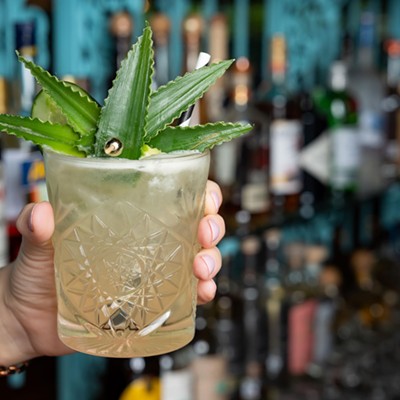It is said that Giacomo Girolamo Casanova, the notorious 18th-century lover, ate 50 oysters each morning for breakfast to increase his sexual stamina. Earlier, herbalist Nicholas Culpepper wrote that asparagus "stirs up lust in man and woman." And back before we even had a word for aphrodisiac, the Aztecs named avocados ahuacuatl, or "testicle tree." The belief in foods as sexual stimulants is not a modern myth.
It's not entirely based upon science either, though. Though some foods possess chemical properties that could increase testosterone or estrogen levels, thereby increasing sex drive, others are considered sexy purely because of their appearance. The Food and Drug Administration maintains that aphrodisiacs are myths with no basis in science.
Still, some people swear by them. So, in honor of Valentine's Day, we bring you some of the foods commonly believed to have aphrodisiac powers, and a bit of research to determine whether or not you're wasting your time by stuffing yourself silly with walnuts.
Oysters In March 2005, American and Italian scientists announced that there is some truth to the idea that bivalves can get folks all hot and bothered. In the study, the scientists took raw oysters and used a process called high-performance liquid chromatography to pinpoint specific amino acids present in the oysters. They discovered D-aspartic acid (D-Asp) and N-methyl-D-aspartate (NMDA), which they injected into rats. These amino acids worked with other chemicals in the rats' bodies to produce testosterone in male rats and progesterone in females, which increases libido. The conclusion: "Yes, I do think these molluscs are aphrodisiacs," said the head of the research team, Dr. George Fisher, a professor of chemistry at Barry University. "If the male is having difficulties, they have to eat a lot of mussels or oysters." And if that doesn't work, there's always the slurping and sucking and vague resemblance of oysters to female anatomy.
Hot peppers It's all about the capsaicin in hot peppers. They don't actually release any sexually stimulating chemicals, but the effects of the capsaicin in the body mimics the effects -- waves of heat, flushed cheeks, sweating, increased heart rate -- of sexual arousal. They also release endorphins, which make you happy and, sometimes, ready to go!
Chocolate Chocolate was a valuable commodity back in the day, and as such, it often found its way into fertility rituals. Aztec emperor Montezuma was rumored to have consumed large amounts of cocoa beans to ready himself for romantic conquests. Today, most researchers believe that the small amounts of tryptophan and phenylethylamine -- both vaguely related to sexual desire -- in chocolate really don't do much. Sure it's sexy because it's delicious and it melts at body temperature, but researchers at the National Institute of Mental Health estimate that a 130-pound person would have to eat 25 pounds of chocolate in a single sitting to get any sort of euphoric feelings from it. And eating that much chocolate at one sitting is definitely not sexy.
Red wine Though we'd all like another excuse to drink even more red wine (I, personally, drink it for cardiac health), the truth is it really doesn't have aphrodisiac properties. All alcohol lowers inhibitions, making one more likely to strike up a conversation with a stranger, lean in for the kiss or bust out some moves in the bedroom, but that's about it. Some studies show that red wine can increase circulation, which definitely helps sexy time, but too much and you'll be unable to achieve arousal.
Nuts Almonds, in particular, have long been touted as aphrodisiacs, but primarily because they're very nutritious, not because they have any intrinsic libidinous qualities. Pine nuts are high in zinc, which men expel when they climax, so the more zinc in the body, the more stamina (supposedly). Mainly, nuts are just really good for you. When you're healthy, sex is better. So eat more nuts!
Asparagus Last week, I told you to not eat asparagus on dates because it makes your pee smell funny. Now, I'm telling you that the green stalks might, might enhance your ability to reach orgasm. Asparagus is a good source of folic acid, which elevates histamines in the body, which, in turn, regulate the body's orgasms. Maybe. How much asparagus would you have to eat for a mind-blowing climax? Probably a lot. And your pee will smell funny. So weigh those pros against that con.
Bananas Obviously, bananas bear a strong resemblance to male anatomy, but aside from the fact that they look like big, yellow phalluses, bananas are packed with potassium and B vitamins, which are essential to sexual hormone production. Many other foods contain the same vitamins and minerals, though, so really, the banana is mainly held up as an aphrodisiac because of its shape. And who among us doesn't recall sex-ed class and trying to put condoms on bananas? OK, now that I think about it like that, bananas are the opposite of sexy.
Avocado We've already established that the Aztecs thought avocados growing in pairs on trees resembled testicles, and, like bananas, their aphrodisiac reputation is based primarily on the way they look. Beyond being a healthy source of fats and nutrients, avocados don't do much for the libido. But man, they're funny looking.
Figs With figs, there is, of course, the connection to the fig leaves that covered Adam and Eve's private regions when they realized they were naked in the Garden of Eden. Any other claims that figs are sexual stimulants is based purely on the fact that, for centuries, people have thought that whole figs resemble male sex organs, while halved ones resemble female sex organs. I don't know what female sex organs the rest of the world is looking at, though, because to me, halved figs look more like brain matter than any other body part.
Honey Today, "honey" is a term of endearment used to imply that someone is sweet, but the sticky stuff's reputation as a love-making tool began in ancient Persia, where couples drank a fermented honey drink called mead every day for a month after they were married to promote a successful marriage (hence, honeymoon). We now know that honey has lots of B vitamins, which are needed for testosterone production. A friend of mine also told me recently that he used to brew his own mead and could personally attest to the fact that it made him horny. So make of that what you will.





